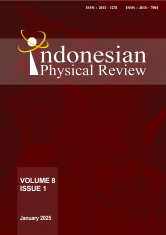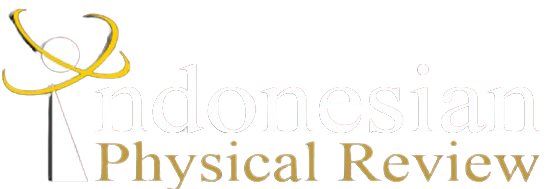THE EFFECT OF CALCINATION TEMPERATURE AND HOLDING TIME ON STRUCTURAL PROPERTIES OF CALCIA POWDERS DERIVED FROM EGGSHELL WASTE
DOI:
10.29303/ipr.v8i1.450Downloads
Abstract
This study investigates the effects of calcination temperature and holding time on the structural properties of calcia (CaO) powders. The raw material used in this study is chicken eggshell waste, which was cleaned, dried, ground, and sieved for uniform particle size. The synthesis of calcia powder was performed by calcining the powder at 900°C and 1000 °C for 5, 10, and 15 hours. XRD, BET, and SEM analyses were employed to evaluate crystal structure, textural properties, and microstructure of the calcined powders. The Rietveld analysis reveals the identified crystalline phases were calcia up to 95.6 mol% and calcium hydroxide as secondary phase. Results indicate that higher calcination temperatures and extended holding times increase particle size and reduce BET surface area, significantly altering pore size distribution. Specifically, elevated temperatures promote sintering and grain growth, leading to smaller average pore radii and decreased total pore volume. The BET surface area ranges from 7.431 m2/g to 1.772 m2/g for samples calcined at 900 °C and from 3.202 m²/g to 0.711 m²/g for samples calcined at 1000 °C. Correspondingly, the average particle radius increases from 183.51 nm to 769.55 nm at 900 °C and from 425.83 nm to 1918.10 nm at 1000 °C as the holding time extends. BJH analysis reveals that longer holding times broaden pore size distribution due to the merging of smaller pores.Keywords:
Calcia Calcination Holding time Microstructure Structure TemperatureReferences
N. A. Zul, S. Ganesan, T. S. Hamidon, W.-D. Oh, and M. H. Hussin, “A review on the utilization of calcium oxide as a base catalyst in biodiesel production,†J. Environ. Chem. Eng., vol. 9, no. 4, p. 105741, Aug. 2021, doi: 10.1016/j.jece.2021.105741.
T. Pagar, S. Ghotekar, S. Pansambal, R. Oza, and B. P. Marasini, “Facile Plant Extract Mediated Eco-Benevolent Synthesis and Recent Applications of CaO-NPs: A State-of-the-art Review,†J. Chem. Rev., vol. 2, no. 3, pp. 201–210, Jun. 2020, doi: 10.22034/jcr.2020.107355.
X. Zhang et al., “A review on granulation of CaO-based sorbent for carbon dioxide capture,†Chem. Eng. J., vol. 446, p. 136880, Oct. 2022, doi: 10.1016/j.cej.2022.136880.
V. K. Yadav et al., “The Processing of Calcium Rich Agricultural and Industrial Waste for Recovery of Calcium Carbonate and Calcium Oxide and Their Application for Environmental Cleanup: A Review,†Appl. Sci., vol. 11, no. 9, Art. no. 9, Jan. 2021, doi: 10.3390/app11094212.
R. Nurlaila, Musyarofah, N. F. Muwwaqor, Triwikantoro, A. Kuswoyo, and S. Pratapa, “Phase analysis of ZrO2-SiO2 systems synthesized through Ball milling mechanical activations,†AIP Conf. Proc., vol. 1788, no. 1, p. 030122, Jan. 2017, doi: 10.1063/1.4968375.
G. Elsandika, A. D. C. Putri, M. Musyarofah, and S. Pratapa, “Synthesis of ZrSiO4 powders by a sol-gel method with varied calcination temperatures,†IOP Conf. Ser. Mater. Sci. Eng., vol. 496, p. 012047, May 2019, doi: 10.1088/1757-899X/496/1/012047.
A. Putkham, S. Ladhan, and A. I. Putkham, “Changing of Particle Size and Pore Structures of Calcium Oxide during Calcinations of Industrial Eggshell Waste,†Mater. Sci. Forum, vol. 998, pp. 90–95, 2020, doi: 10.4028/www.scientific.net/MSF.998.90.
A. H. Prayitno, B. Prasetyo, and A. Sutirtoadi, “Synthesis and characteristics of nano calcium oxide from duck eggshells by precipitation method,†IOP Conf. Ser. Earth Environ. Sci., vol. 411, no. 1, p. 012033, Jan. 2020, doi: 10.1088/1755-1315/411/1/012033.
Y. M. Alobaidi, M. M. Ali, and A. M. Mohammed, “Synthesis of Calcium Oxide Nanoparticles from Waste Eggshell by Thermal Decomposition and their Applications,†Jordan J. Biol. Sci., vol. 15, no. 2, pp. 269–274, 2022, doi: 10.54319/jjbs/150215.
J. S. J. Ling, Y. H. Tan, N. M. Mubarak, J. Kansedo, A. Saptoro, and C. Nolasco-Hipolito, “A review of heterogeneous calcium oxide based catalyst from waste for biodiesel synthesis,†SN Appl. Sci., vol. 1, no. 8, p. 810, Jul. 2019, doi: 10.1007/s42452-019-0843-3.
M. Musyarofah et al., “Ultra-dense (Bi, V, B)-oxide-added zircon ceramics fabricated by liquid-phase assisted spark plasma sintering (SPS),†Mater. Res. Express, vol. 10, no. 5, p. 055002, May 2023, doi: 10.1088/2053-1591/acd521.
N. Nurhayati, M. Musyarofah, S. Rahastama, D. M. Shoodiqin, B. Prayitno, and N. Puspitasari, “Study of The Effect of Calcination Temperature on the Phase Composition of ZnO Powder Synthesized via The Sol-Gel Method,†J. ILMU Fis. Univ. ANDALAS, vol. 16, no. 1, Art. no. 1, Feb. 2024, doi: 10.25077/jif.16.1.71-78.2024.
B. Peceño, B. Alonso-Fariñas, L. F. Vilches, and C. Leiva, “Study of seashell waste recycling in fireproofing material: Technical, environmental, and economic assessment,†Sci. Total Environ., vol. 790, p. 148102, Oct. 2021, doi: 10.1016/j.scitotenv.2021.148102.
N. Azmi, S. Yusup, and K. M. Sabil, “Effect of water onto porous CaO for CO2 adsorption: Experimental and extended isotherm model,†J. Clean. Prod., vol. 168, pp. 973–982, Dec. 2017, doi: 10.1016/j.jclepro.2017.08.225.
Q. Song, X. Zha, M. Gao, and Y. Ma, “Influence of raw material purity on microstructure and properties of calcia refractory,†J. Eur. Ceram. Soc., vol. 44, no. 3, pp. 1847–1855, Mar. 2024, doi: 10.1016/j.jeurceramsoc.2023.10.051.
P. Kashyap, M. Brzezińska, N. Keller, and A. M. Ruppert, “Influence of Impurities in the Chemical Processing Chain of Biomass on the Catalytic Valorisation of Cellulose towards γ-Valerolactone,†Catalysts, vol. 14, no. 2, Art. no. 2, Feb. 2024, doi: 10.3390/catal14020141.
N. Uporova and L. Leonova, “Investigation of the impurity effect on the kinetics of thermal decomposition of natural gypsum at high temperatures,†Results Chem., vol. 12, p. 101867, Dec. 2024, doi: 10.1016/j.rechem.2024.101867.
D. Wang, C. Shi, N. Farzadnia, Z. Shi, H. Jia, and Z. Ou, “A review on use of limestone powder in cement-based materials: Mechanism, hydration and microstructures,†Constr. Build. Mater., vol. 181, pp. 659–672, Aug. 2018, doi: 10.1016/j.conbuildmat.2018.06.075.
Musyarofah, E. F. Damanik, A. R. Septiana, D. M. Shoodiqin, Husain, and G. Yudoyono, “Phase study of Mg1-xZnxTiO3 powders prepared by dissolved metals mixing method,†AIP Conf. Proc., vol. 2652, no. 1, p. 050013, Nov. 2022, doi: 10.1063/5.0106315.
K. R. Hallam, J. E. Darnbrough, C. Paraskevoulakos, P. J. Heard, T. J. Marrow, and P. E. J. Flewitt, “Measurements by x-ray diffraction of the temperature dependence of lattice parameter and crystallite size for isostatically-pressed graphite,†Carbon Trends, vol. 4, p. 100071, Jul. 2021, doi: 10.1016/j.cartre.2021.100071.
L. Huang, G. Cheng, and S. Huang, “Effects of Calcination Conditions on the Formation and Hydration Performance of High-Alite White Portland Cement Clinker,†Materials, vol. 13, no. 3, Art. no. 3, Jan. 2020, doi: 10.3390/ma13030494.
J. M. Valverde, P. E. Sanchez-Jimenez, and L. A. Perez-Maqueda, “Limestone Calcination Nearby Equilibrium: Kinetics, CaO Crystal Structure, Sintering and Reactivity,†J. Phys. Chem. C, vol. 119, no. 4, pp. 1623–1641, Jan. 2015, doi: 10.1021/jp508745u.
M. A. Al-Ghouti and D. A. Da’ana, “Guidelines for the use and interpretation of adsorption isotherm models: A review,†J. Hazard. Mater., vol. 393, p. 122383, Jul. 2020, doi: 10.1016/j.jhazmat.2020.122383.
H. Mangal, A. Saxena, A. S. Rawat, V. Kumar, P. K. Rai, and M. Datta, “Adsorption of nitrobenzene on zero valent iron loaded metal oxide nanoparticles under static conditions,†Microporous Mesoporous Mater., vol. 168, pp. 247–256, Mar. 2013, doi: 10.1016/j.micromeso.2012.10.006.
D. P. Lapham and J. L. Lapham, “Gas adsorption on commercial magnesium stearate: Effects of degassing conditions on nitrogen BET surface area and isotherm characteristics,†Int. J. Pharm., vol. 530, no. 1, pp. 364–376, Sep. 2017, doi: 10.1016/j.ijpharm.2017.08.003.
Y. Zhao et al., “Effects of calcination temperature on grain growth and phase transformation of nano-zirconia with different crystal forms prepared by hydrothermal method,†J. Mater. Res. Technol., vol. 19, pp. 4003–4017, Jul. 2022, doi: 10.1016/j.jmrt.2022.06.137.
S.-B. Lee, E.-H. Ko, J. Y. Park, and J.-M. Oh, “Mixed Metal Oxide by Calcination of Layered Double Hydroxide: Parameters Affecting Specific Surface Area,†Nanomaterials, vol. 11, no. 5, Art. no. 5, May 2021, doi: 10.3390/nano11051153.
Z. Ž. Vasiljević et al., “Exploring the impact of calcination parameters on the crystal structure, morphology, and optical properties of electrospun Fe 2 TiO 5 nanofibers,†RSC Adv., vol. 11, no. 51, pp. 32358–32368, 2021, doi: 10.1039/D1RA05748K.
J. P. Ramos, C. M. Fernandes, T. Stora, and A. M. R. Senos, “Sintering kinetics of nanometric calcium oxide in vacuum atmosphere,†Ceram. Int., vol. 41, no. 6, pp. 8093–8099, Jul. 2015, doi: 10.1016/j.ceramint.2015.03.007.
R. Han et al., “Progress in reducing calcination reaction temperature of Calcium-Looping CO2 capture technology: A critical review,†Chem. Eng. J., vol. 450, p. 137952, Dec. 2022, doi: 10.1016/j.cej.2022.137952.
S. Chuakham et al., “Scalable production of bio-calcium oxide via thermal decomposition of solid - hatchery waste in a laboratory-scale rotary kiln,†Sci. Rep., vol. 15, no. 1, p. 865, Jan. 2025, doi: 10.1038/s41598-024-84889-w.
License

This work is licensed under a Creative Commons Attribution-NonCommercial-ShareAlike 4.0 International License.
Authors who publish with Indonesian Physical Review Journal, agree to the following terms:
- Authors retain copyright and grant the journal right of first publication with the work simultaneously licensed under a Creative Commons Attribution-ShareAlike 4.0 International Licence (CC BY SA-4.0). This license allows authors to use all articles, data sets, graphics, and appendices in data mining applications, search engines, web sites, blogs, and other platforms by providing an appropriate reference. The journal allows the author(s) to hold the copyright without restrictions and will retain publishing rights without restrictions.
- Authors are able to enter into separate, additional contractual arrangements for the non-exclusive distribution of the journal's published version of the work (e.g., post it to an institutional repository or publish it in a book), with an acknowledgment of its initial publication in Indonesian Physical Review Journal.
- Authors are permitted and encouraged to post their work online (e.g., in institutional repositories or on their website) prior to and during the submission process, as it can lead to productive exchanges, as well as earlier and greater citation of published work (See The Effect of Open Access).





